Identifying Archival Silences in the Attica Uprising Collection
“…Any historical narrative is a particular bundle of silences, the result of a unique process, and the processes required to deconstruct these silences will vary accordingly.”
Michel-Rolph Trouillot, Silencing the Past: Power and the Production of History, p. 27
In a recent episode of Backstory, a history podcast produced through Virginia Humanities, historian and co-host Ed Ayers commented:
“You talked about the artifacts…I think that’s one reason the museum isn’t [an] especially volatile, dangerous and important place to have these things. If you read surveys Americans say…that they trust museums more than any other institutions to explain the past. It’s something about the reality of the artifact, you can’t argue.[i]
Arguably one of the most important aspects of museum collections and one of the primary attractions of museum exhibitions is the tangible connection to history that is afforded by visitors being in the presence of the physical objects—the remnants of the past. Historian David Lowenthal, in the revised edition of his seminal work, The Past is a Foreign Country (Revisited), explores the significant role played by museums and their collections in the development and dissemination of collective memory. Lowenthal cites three “sources” for attaining knowledge about the past: “memory, history, and relics.” These relics, unlike memory or history, offer “residues” of the past that are often seen as more tangible when in their presence.[ii] Thus, museums and their collections have traditionally benefited from a perception of authenticity with which to present historical information. The use of artifacts, according to Lowenthal, enables museum visitors to “furbish our awareness of the past.”[iii] Yet, this widely-accepted public perception of artifacts as impartial arbiters of past events can be problematic as museums and historians increasingly seek to present more balanced and nuanced historical narratives, particularly about potentially divisive and controversial topics. Museums can not be content with a patina of trust; that trust must be earned. Nor should they be satisfied with simply allowing the artifacts to speak for themselves without first exploring ways in which their collections may omit significant portions of the narrative.
While Lowenthal highlights the importance of relics in establishing the historical record, he cautions against the unquestioning certainty of the past that the tangible “residues” may offer. Failure to recognize that artifacts and their meanings can be altered, revised, and distorted over time, or because of circumstance, can significantly influence the development of history.[iv] While professional historians are trained to thoroughly examine sources with a critical eye towards potential biases or distortions, Lowenthal keenly points out the pitfalls of this purely academic notion when examining collective memory and perception of history in the public sphere.[v]
It is against this cautionary word that we should also look at the work of Haitian-born historian Michel-Rolph Trouillot. In his book Silencing the Past: Power and the Production of History, Trouillot forcefully articulates the role that power plays in the creation of the historical narrative. Trouillot’s argument is more than simply an expansion of the adage that history is written by the victors. Rather, Trouillot makes the case that not only is the history itself thus created, but that those in positions of power also are instrumental in the creation of silences that often obscure a more total understanding of past events.
Trouillot explores the “many ways in which the production of the historical narrative involves the uneven contributions of competing groups and individuals who have unequal access to the means of such production.”[vi] Trouillot’s book identifies the ways in which archival silences are constructed within the formation of historical narratives: the moment of fact creation (making of sources); the moment of fact assembly (making of archives); moment of fact retrieval (making of narratives); and the moment of retrospective significance (making of history in the final instance).[vii]
Such archival silences most likely can be found in virtually every museum collection. The impact or significance of how archival silences are presented or obscured inevitably affects how collective memory of a given event is perceived in the general public. It is therefore critical that not only practicing public historians, but also the general museum visitor be increasingly aware of the potential for biases, omissions, or obfuscations even within the physical remains of the past contained within museums.
As noted in the quote atop this essay, these constructed silences within the archival records are rarely created in the same manner, nor can they be deconstructed using a single, universal method.[viii] Rather, it is in the awareness of these silences that public historians can seek to engage the audience in a dialog about the creation of the historical narrative, emphasize the need for independent critical thinking, and improve awareness of the potential for silences within museum collections. The following discussion presents a proposed case study for a more critical examination of archival silences within museum collections by providing an in-depth look at the 1971 Attica Prison Uprising collections at the New York State Museum and the potential applications of digital history and data analysis within the oftentimes stagnant world of museum collections databases as a tool to bring these silences to the forefront. Through these discussions, potential methods for deconstructing these silences will be examined.
The events surrounding the prisoner uprising at Attica State Correctional Facility in September 1971 afford a comprehensive case study for Trouillot’s theories surrounding power and history. Study of the Attica artifacts without this eye towards the silences created in the archival record would risk, as Trouillot warns, reaffirming “that a particular narrative legitimates particular policies” and refers “implicitly to a “true” account of these policies through time.” Such single-site historicity threatens to obfuscate any other potential narratives that exist surrounding the events at Attica.[ix] Indeed, memory of the events at Attica is chock full of these archival silences. From the first public statements falsely laying blame for the deaths of hostages at the hands of prisoners; to the collection of the physical evidence which forms the material foundation for the project in efforts by the New York State Police, as argued by Heather Ann Thompson, to incriminate prisoners in a variety of crimes; to the legal morass that spanned more than 30 years in which the narrative was argued and obfuscated at multiple points; the history of the Attica prison uprising witnessed repeated examples of the uses of power in the creation of silences within the narrative. These silences remain prevalent in the material collections now at the New York State Museum.

In the summer of 2010, nearly four decades after the 1971 Attica Prison Uprising, New York State Police at Troop A in Batavia contacted New York State Museum Senior Historian Craig Williams. The Troopers had encountered evidence from the uprising in a Quonset hut and were preparing to dispose of the materials unless the New York State Museum should have interest. After four separate trips with cargo vans from Albany, museum staff transported 2,192 artifacts to the museum’s off-site storage facility where they were inventoried, photographed, and rehoused in archivally sound boxes. Such a rare windfall of artifacts pertaining to a watershed moment in not only New York State, but national history, would under normal circumstances provide the museum with the foundations for extensive research and exhibition potential. As critical examination makes apparent, however, the Attica evidence should not be viewed as a normal collection. In order to fulfill its obligations to the public trust, the state museum and researchers of the Attica collections must approach the material objects with a skepticism and an awareness of the myriad silences within this archival record.
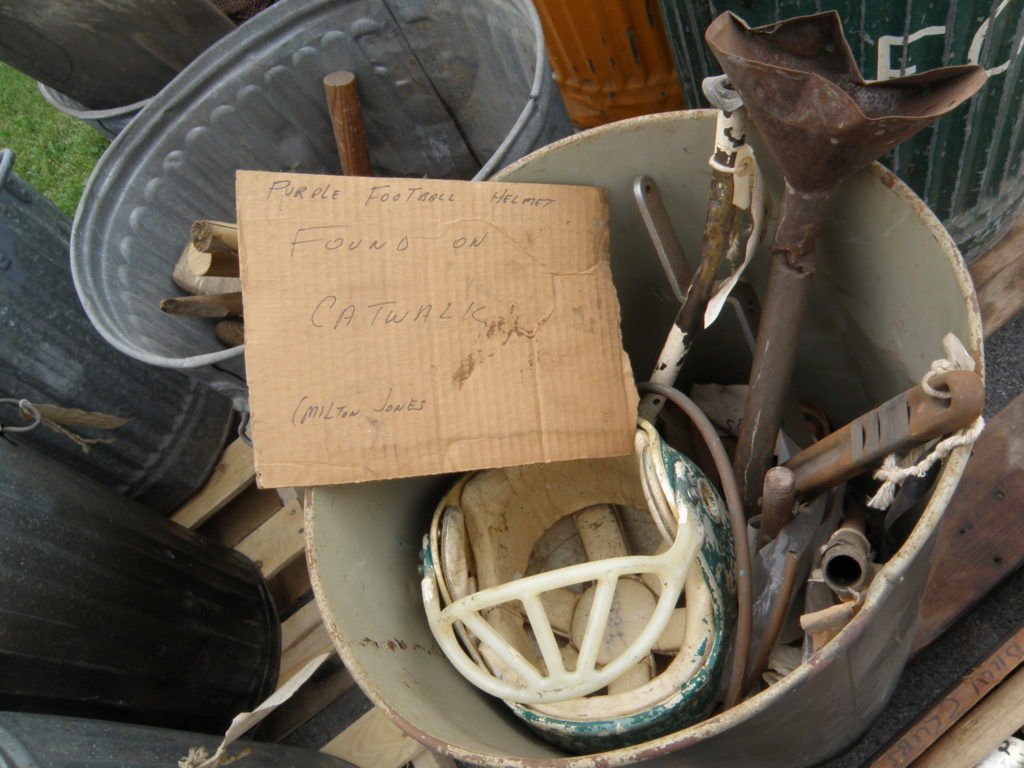
The Attica Uprising, September 9-13, 1971
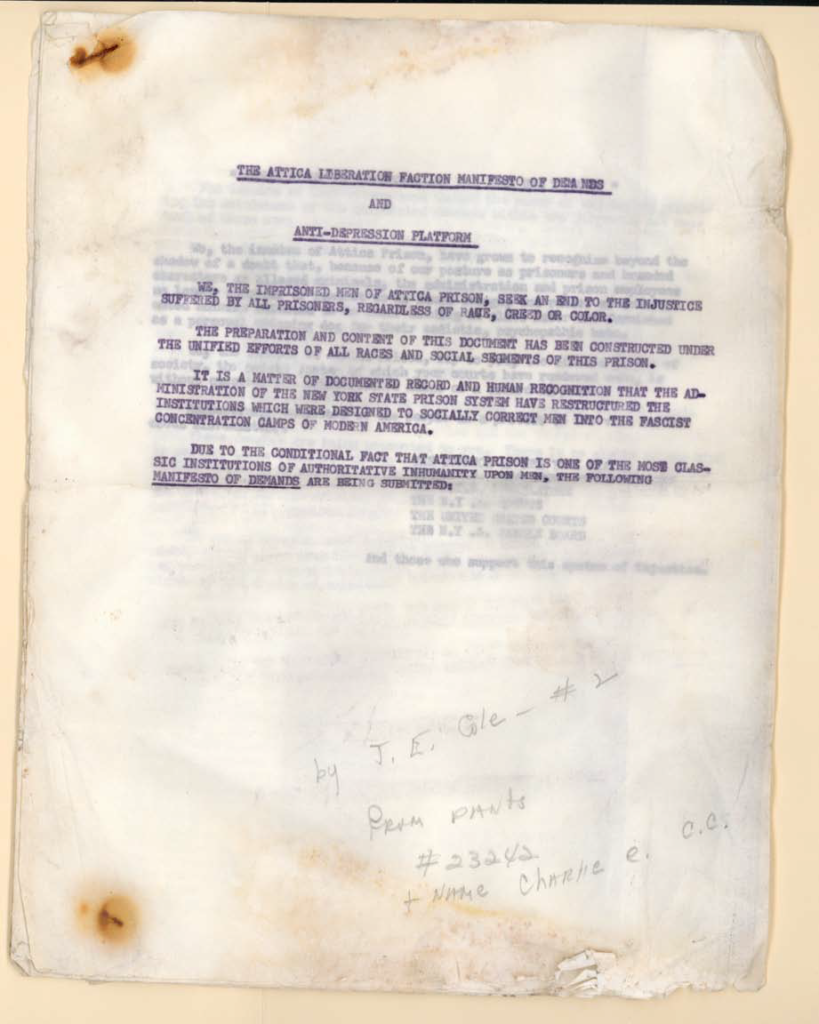
This is the only known surviving copy of the July Manifesto issued by the Attica Liberation Faction. The document details the “strikingly reasonable and civil approach to setting their grievances and demands before the Commissioner” taken by the prisoners at Attica.[xi] While including some “harsh rhetoric” reflective of the turbulence of the era, the demands focus primarily on improving conditions within the prison. (New York State Museum Collection, H-2010.30.1672)
The Attica prison uprising, which left 43 people dead and 100s wounded, played out in the backdrop of the racially charged late 1960s and 1970s.[x] The Attica prison, located in Wyoming County, opened in 1931 and was originally intended to house prisoners from upstate. However, by the 1960s Attica became the overflow facility for New York City area offenders which led to racial tensions between the predominantly minority prison population and white guards (in 1970, the Attica prison population was 54% black, 37% white, and 9% Latino – while the general NYS population was less than 12% black).[xii] The racial disparity coupled with overcrowding (Attica was built for 2,000 inmates, but in 1971 housed 2,243 inmates) and combined with the troubling poor conditions at the prison resulted in a tinderbox of explosive tension by the summer of 1971. Attica Correctional Facility was not significantly updated in the four decades since it opened. Cell bars were thick with rust, wind passed through cracks and holes in the cement walls. The cells offered virtually no heating in the frigid upstate New York winters and were stiflingly hot during the summer months. The State of New York allocated only $0.63 per inmate per day for food. Meals were insufficient to meet the minimum dietary standards established by federal guidelines. Prisoners were allowed only one bar of soap and one roll of toilet paper each month. Most prisoners at Attica earned only $0.06 per day at the various jobs assigned at Attica, with the luckiest taking in $2.90. Prisoners were forced to spend 15-24 hours of every day in the cramped confines of their cells.[xiii]
In July 1971 a group of prisoners calling themselves the Attica Liberation Faction presented Russell Oswald, the Commissioner of Correctional Services, with a list of demands including reform of the NYS parole system, improved living conditions, better medical care, improved wages in prison industry, and better oversight of facility staff. While Oswald publicly agreed with many of the called-for changes, progress was slow, and tensions continued to rise.[xiv] In August after Black Panther leader George Jackson, a prisoner in San Quentin Correctional Facility in California, was killed by a guard during an attempted escape. In protest, Attica prisoners executed a hunger strike, which put many of the guards on edge. On the morning of September 9, 1971, a heated-exchange between prisoners and guards led to a prisoner rebellion, which soon escalated and spread as the prisoners overpowered the guards who were few in numbers. Forty-two guards and prison employees were taken hostage and 1,300 inmates participated in the riot.
For the next four days, prisoners negotiated with Commissioner Oswald on the same fundamental issues they had asked for weeks prior, but with the additional demand of complete amnesty. At the request of the prisoners, over thirty-five observers and members of the press were called to Attica to assist with negotiations. On September 11 news that Officer William Quinn had died from head injuries received during the outbreak of the riot escalated the worsening tensions between the state and prisoners. Governor Rockefeller refused to intervene and travel to Attica for negotiations and on the morning of September 13, Rockefeller authorized New York State Police to retake the institution by force.
Silences at the Moment of Fact Assembly

(New York State Museum Files) 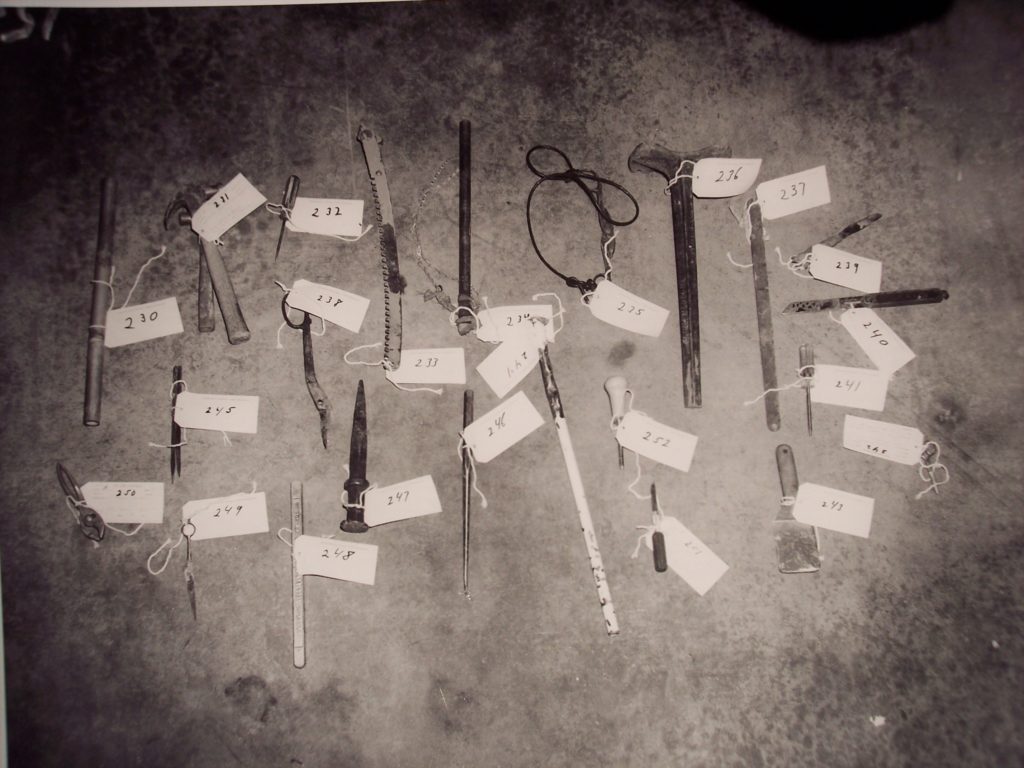
(New York State Archives) 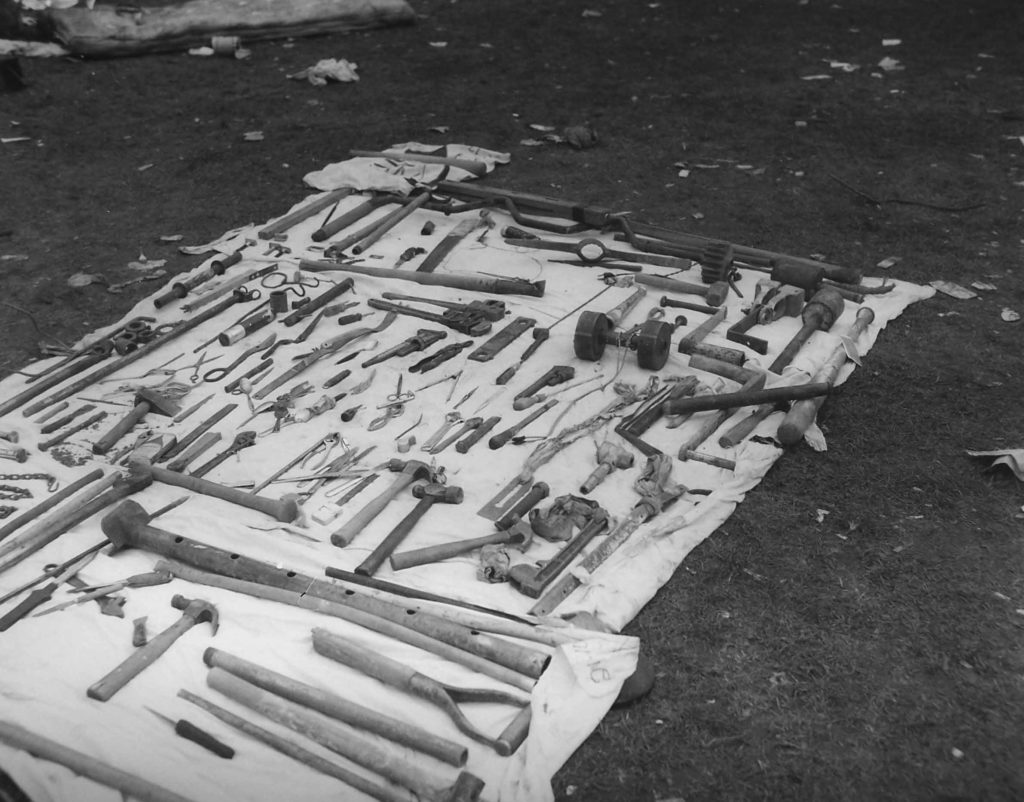
(New York State Archives) 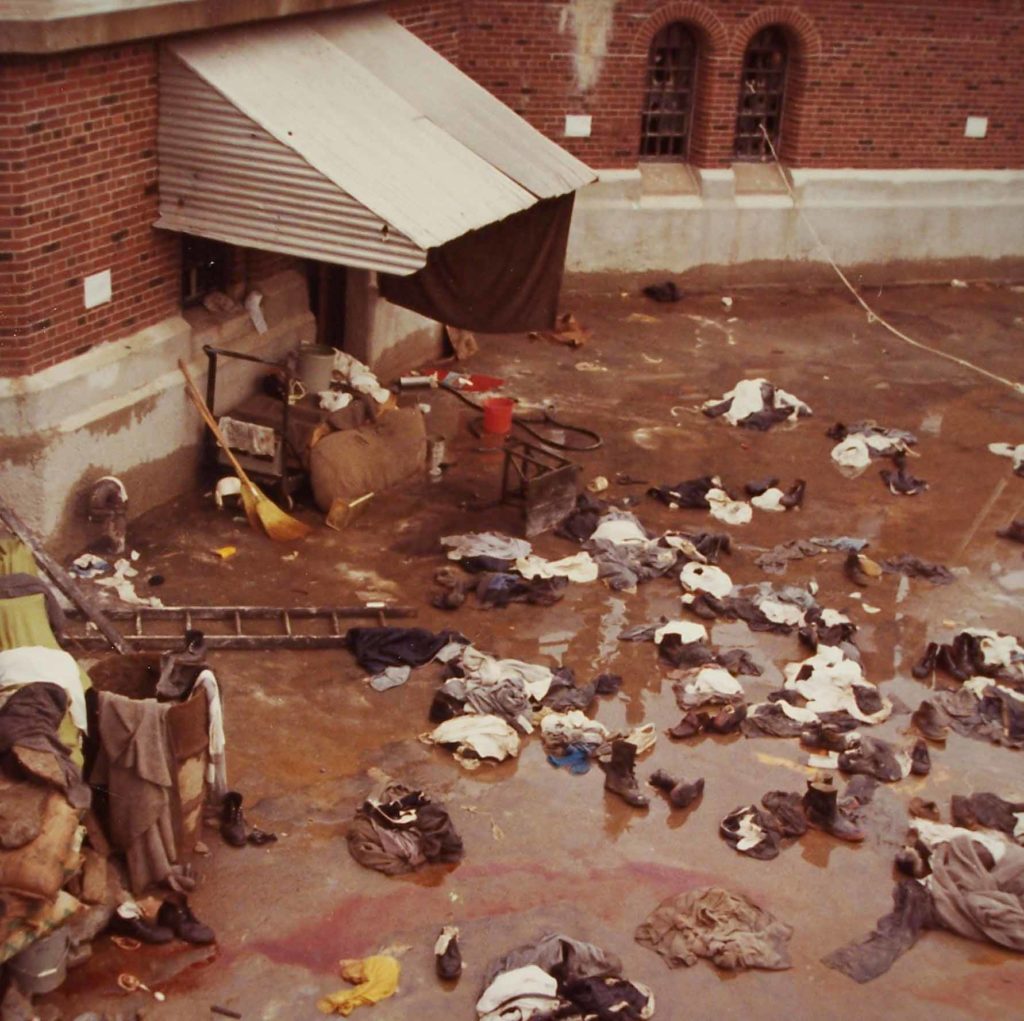
Objects strewn across D Yard at Attica State Correctional Facility shortly after the retaking. Numerous archival silences within the Attica Uprising Collections at the New York State Museum emerged at the moment of “fact assembly” in September 1971. (New York State Archives)
On September 13, 1971, Troopers from the New York State Police, corrections officers, and local law enforcement brought the four-day standoff at the Attica State Correctional Facility to a violent and bloody conclusion. During the uprising, Corrections Officer Quinn and three prisoners had been killed, yet the forcible retaking of the New York State Prison left an additional 39 people dead including 9 hostages. All had been killed by gunfire from law enforcement. Immediately after the retaking at Attica, State Police offered often “exaggerated, embellished, and even fabricated” accounts of the events within the prison facility. Many of these detailed alleged “hostile” acts on the part of prisoners during the assault.[xv]
Within hours of the assault, investigators from the New York State Police’s Bureau of Investigation began combing the prison grounds collecting evidence for potential future prosecutions of prisoners who had participated in the rebellion. Despite the fact that the victims at Attica had died from gunshot wounds, the focus of investigators was exclusively on the incrimination of the prisoners in D Yard rather than an impartial search for answers. The Meyer Report, commissioned by the State of New York to investigate allegations of a cover-up in the Attica investigations, found that “The State Police should have been removed from any role whatsoever in the initial gathering of evidence of what happened during the retaking, or in any subsequent investigation of the Attica events…”[xvi] Meyer goes on to criticize the “extraordinarily deficient” implementation and “planning by the State Police for the gathering of evidence related to the retaking and their acts and omissions to act in this connection during the first twenty-four hours after conclusion of the retaking on the morning of September 13, 1971.”[xvii] The Meyer Report explicitly identifies the silences created within the evidentiary collection when the New York State Police failed to account for ballistic evidence, weapons accountability, or to follow rudimentary procedures of police evidence collection in the aftermath of the retaking. In these failures, the State Police initiated the creation of silences at both the “moment of fact creation” and “fact assembly.”[xviii] While Meyer’s report rejects the notion of an intentional cover up at Attica, the investigation described multiple errors in judgement in which evidence and memories of the retaking were not collected in a timely manner.[xix] Intentional or not, the decisions made by State Police and other investigators in the wake of the tragedies at Attica illustrates how power influences the production of both the historical narrative as well as silences within the archival record.
Immediately after the retaking of Attica, Governor Rockefeller and other state officials began applauding the actions of the State Police. This early praise served to solidify the positive view of the actions of law enforcement within the public consciousness, which proved difficult to rectify as evidence of potential wrongdoing emerged.[xx] At the same time, corrections and law enforcement officials publicly recounted uncorroborated tales of prisoner cruelty and crimes, including that all hostages had been murdered by prisoners, thus establishing a narrative that lay all responsibility for the tragic events at Attica upon the prisoners.[xxi] Rather than accept responsibility for the deaths of 40 people on September 13, according to Heather Ann Thompson, the State of New York “chose ‘not to apologize for, or…correct the false press release about the stabbing and castration, but [instead] to show pictures of all the weapons found in D yard—clubs, knives, screwdrivers, and hammers.’”[xxii] In lieu of an apology, these weapons became visual justification for the bevy of shots fired by state law enforcement during the retaking. The early formation of public perceptions based upon significant and numerous falsehoods continues to plague collective memory of the Attica Uprising.
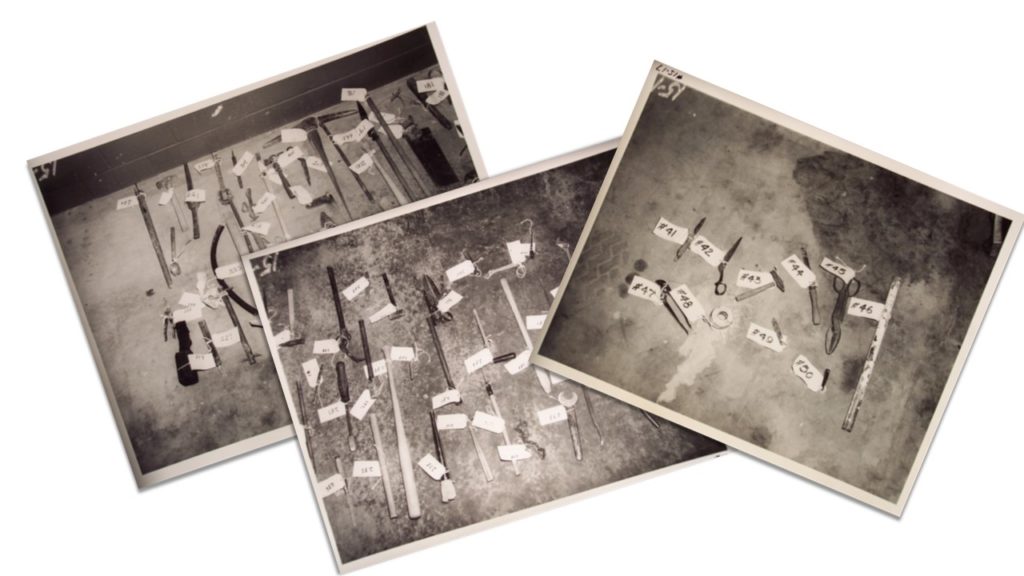
The chart shows the disparity regarding the number of “weapons” collected by State Police investigators. Other items, which were classified as “tools” at the New York State Museum, include screwdrivers, hammers, and other implements that were likely identified as criminal evidence because of their potential utility as weapons. The investigators’ focus on establishing prisoners’ guilt in crimes committed during the uprising resulted in a notable absence of evidentiary materials documenting potential crimes committed by law enforcement during the retaking of Attica on September 13, 1971.
Questions regarding classification of objects within the Attica collections at the New York State Museum illustrates the challenges involved in documenting and cataloging these historical materials absent the context in which they were initially collected. Here, the protocols by which museums traditionally catalog artifacts collides with the realities of how these items were collected in the past at the point of archival creation. Standard museum classification and nomenclature systems seem largely inadequate for the unique histories preserved in the material culture of the Attica Prison Uprising collection. How, for example, does a museum collections cataloger document a screwdriver recovered at Attica? Should it be documented in museum databases according to its intended use at the time of manufacture? Should it be recorded as a weapon, as it was most likely perceived by State Police investigators in 1971 when it was collected? How should silences and other forms of omission or obfuscation that arise within a museum collection such as this be recorded for future historians? Does failure to account for and acknowledge such silences at the cataloging phase – a period when levels of interpretation are traditionally kept to a minimum – risk perpetuation of these archival silences? At what point does a museum professional have an obligation to begin making interventions into the archival record? Questions such as these continue to plague the Attica collections at the New York State Museum.
Example 1: The “Rocket Launcher”
The artifact featured in the photograph below offers a glimpse into the degree to which State Police investigators were willing to go in order to frame the evidence in the worst potential light for the prisoners. The “rocket launcher” was recovered in D Yard following the retaking of Attica. According to the McKay Commission Report, while it was most likely constructed by prisoners as a visually threatening piece of bravado hoping to deter a forcible retaking of the prison, the object was, according to the report, ultimately “a dud.”[xxiii] By contrast, a 1971 New York State Police Bomb Squad report states, “This device was constructed of an empty oxygen cylinder and various other unrelated objects as can be seen in the photograph. This item could not function as a cannon in the normal sense of the word and would appear to be only an attention-getter. Close examination, however, will disclose tin cans which have been soldered together to form tubes open at one end and mounted at either side of the compressed gas cylinder. These tubes could have been easily filled with some flammable liquid and ignited. Heat from such a source would have the potential of causing the gas in the cylinder to expand and explode. This could cause injury as a result of the fragmentation of the exploding tank.”[xxiv] As indicated by the conclusions drawn by New York State Police investigators demonstrates an extreme willingness to assume a high level of planning and coordination on the part of the prisoners during the collection of evidence at the prison regardless of the impracticality of such processes during the retaking. The narrative created by the State Police report nonetheless presents a stark portrayal of prisoners’ motivations and intent.
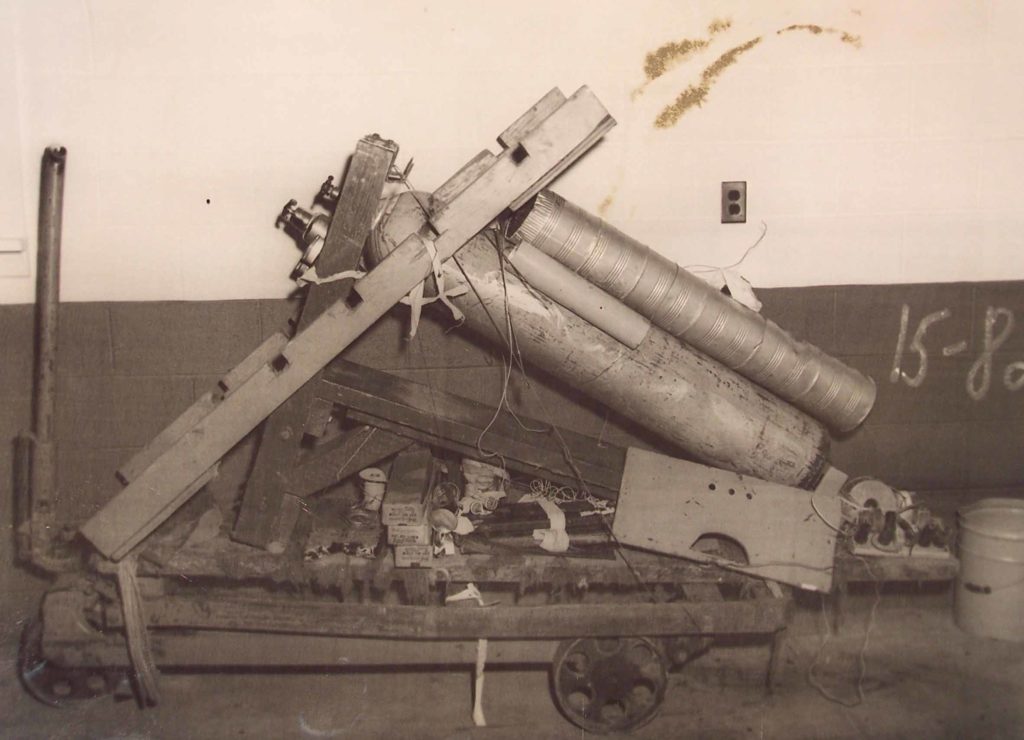
(New York State Archives)
Example 2: Technical Sergeant Walter Hornberger, New York State Police (Ret.)
During an oral history interview conducted December 1, 2010 between now-retired State Museum Senior Historian Craig Williams and Walter Hornberger, a retired member of the New York State Police bomb disposal unit who had been dispatched to Attica in the wake of the uprising, Hornberger discusses items recovered during his time at the prison: “We virtually, the three of us, virtually searched the entire prison, top to bottom, all the underneath walkways, crawl spaces, everything. A very, very exhaustive search. It was difficult, because tear gas was still everywhere. Every place, everything we touched was loaded with tear gas, we were tearing all the time, it was terrible. We did find a wooden gun, a small wooden gun that someone had carved, a facsimile of a revolver, but primarily what we had recovered were literally hundreds of incendiary devices, Molotov cocktails.” (emphasis by author)
We did find a wooden gun, a small wooden gun that someone had carved, a facsimile of a revolver, but primarily what we had recovered were literally hundreds of incendiary devices, Molotov cocktails.
Walter Hornberger, December 1, 2010
Oral History Files, New York State Museum
The carved pistol appears very realistic and Troopers would likely and understandably have confused it for an actual firearm in the midst of the retaking of the facility. As the map above indicates, however, the artifact was recovered in B Block, well away from the violence of the morning of September 13th. The decision to include the piece within the evidence collection despite its discovery outside of D Yard seemingly adds credence to Thompson’s argument that State Police investigators were intent on incrimination of the prisoners in the aftermath of the uprising. When lumped in with other “weapons” accumulated in the evidence recovery process and subsequently laid out for public consumption, artifacts like these were instrumental in state efforts to craft the narrative of events at Attica and are illustrative of the manner that state power was employed in creating silences within the Attica archival record that remain to present day.
Example 3: Malcolm Bell: Blowing the Whistle; Identifying Archival Silence
Malcolm Bell, a former prosecutor with New York State’s Attica Investigation, became so disillusioned with the lack of cooperation by New York State Police and the apparent lack of accountability that he took his concerns to New York Governor Hugh Carey and Attorney General Louis Lefkowicz. Bell recalls concerns about the apparent lack of any evidence pertaining to troopers’ actions during the retaking of the prison, and notes that “Bureau of Criminal Investigation (BCI) detectives had collected the evidence of what troopers did during the retaking. How they collected it—or didn’t collect it—was not specifically part of our orientation.”[xxiv] Through Bell’s recollection and recounting of the evidence recovery operations at Attica, one glimpses the creation of Trouillot’s archival silences in the Attica Collections at the moment of fact creation. Not only does Bell indicate the failure of investigators to collect evidence pertaining to potential law enforcement crimes, but that the “savagery” of some troopers, Bell alleges, “triggered the destruction of evidence by their brother detectives who were supposed to preserve it.”[xxv] Bell states that one of his motivations for coming forward with his concerns was his belief that “So long as the Attica Investigation failed to indict any troopers, it endorsed the Official Version for anyone who noticed.”[xxvi] According to the Meyer Report, “The deficiencies in evidence gathering immediately following the retaking left so little available…” in relation to the actions of law enforcement as to render determination and subsequent interpretation of precisely what occurred “inordinately difficult.”[xxvii] Thus, from the perspective of the museum collections and standard practices in exhibition development, traditional interpretation of the events at Attica that is reliant on the material culture and artifactual evidence will be wholly inadequate in efforts to portray the narrative history of the events to include multiple viewpoints and voices. Historians and curators will need to think creatively as to how to overcome the silences created within the Attica collections in order to convey this difficult history to visitors in any future exhibition.
As the map above illustrates, State Police investigators veered wildly from long established protocols for the collection and documentation of evidence pertaining to potential criminal activity. While many of the objects within the collection now at the New York State Museum were documented and tagged as to the locations within the Attica prison facility where they were secured, a significant percentage of materials were simply thrown into garbage cans with absolutely no corresponding documentation. No efforts were apparently made to identify what activities the supposed evidence documented, nor which potential prisoner may have been affiliated with what object or if any potential crime was perpetrated with a given item. Rather, the material appears to serve no other purpose than the visual condemnation of the prisoners’ actions as noted by Heather Ann Thompson above.
Once again, the interactive collections dashboard facilitated connections between written histories of the events at Attica with artifacts within the State Museum’s collection. In this case, we draw connections between artifacts and Malcolm Bell’s interactions with the State Police during the Attica Investigation.
One of the defendants in Indictment No. 10 was said to have used this one to smash the inch-thick bulletproof glass window in the door of the C Block office. Then he dropped it on a guard inside.
Malcolm Bell, The Great Attica Turkey Shoot, p. 45
Malcolm Bell describes one trip to Batavia, New York as part of the Attica Investigation to view evidence at the Troop A Evidence Garage (presumably the same Quonset hut in which the material was still stored in 2010) in 1973: We wanted to visit their garage, which held inmates’ weapons and some other evidence from the riot and to see the heavy iron crank handle. Normally such handles were used to crank all the door locks open or shut in a gallery of cells. One of the defendants in Indictment No. 10 was said to have used this one to smash the inch-thick bulletproof glass window in the door of the C Block office. Then he dropped it on a guard inside. I once tried breaking a piece of this glass with a similar handle. It would be embarrassing if the defense proved to the jury that it could not be done after my witness testified that he saw it happen…“[xxviii]
The events detailed by Malcolm Bell in Batavia illuminate the continued efforts of State Police investigators to continue to obfuscate attempts to ascertain the truth about events at Attica. Despite Bell’s role as a prosecutor for New York State, members of the State Police were hesitant to allow him opportunity to conduct his experiment with the crank handle. It is unclear from Bell’s account whether the trooper was concerned that the narrative constructed by the State Police in the aftermath of the uprising would unravel if investigated too far, or if there was simply a general mistrust of any endeavors that threatened to shed light on the archival silences created by New York State.
The door crank handle described in the Malcolm Bell example also serves as a case study regarding the challenges of classifications within the museum collections protocols. Objects such as these handles would, under normal circumstances, be classified within museum cataloging nomenclature as building components as their intended usage was as part of the operations of a man-made structure. In the case of the Attica collection, however, Bell indicates that at least one of these handles was potentially used by a prisoner as a weapon. The handle was almost certainly collected by State Police investigators in this light. How then, should museum curators treat this object within the collections database? Does the existing classification structure threaten to obscure the story this artifact can tell? Does wholesale acceptance of the State Police interpretation of the object likewise obscure the narrative as it relates to this artifact? How can these varied interpretations be recorded for future researchers of the collection? Is there an obligation on the part of the State Museum to make these distinctions evident within the catalog record? There are no immediate or easy answers to these questions in relation to the objects within the Attica Collection, yet these questions must be grappled with in the course of further research and development of the Attica database and preparations for future exhibitions.
Increased Awareness; Increased Access
While the events at Attica captivated national attention at the time, the memory of the uprising has largely faded from the wider collective memory, though the tragedies and lessons of Attica continue to resonate within communities of color today. This trend affirms the arguments made by Kenneth Foote that some sites of tragedy and violence “may assume meaning for the minority group, but time must pass before the minority cause symbolized by the site is accepted by a larger constituency.”[xxix] Only recently, as we approach the fiftieth anniversary of the uprising, has Attica begun to reemerge in the larger consciousness. Historian Heather Ann Thompson’s Pulitzer Prize-winning book Blood in the Water: The Attica Prison Uprising of 1971 and its Legacy has sparked renewed conversation and debate over the events at the Attica State Correctional Facility has brought renewed interest and controversy to the collections at the New York State Museum.
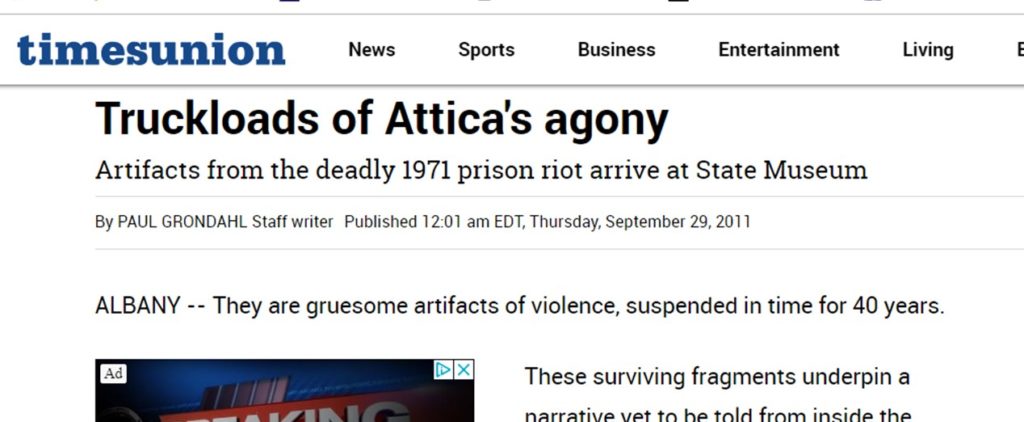
The interactive collections dashboard is designed to facilitate awareness of the artifacts within the museum’s collection and to provide increased access to these materials. By placing the objects in a spatial context relative to their locations within the Attica prison facility, we hope to achieve a greater appreciation of the complexity of events that occurred at Attica and how the objects themselves have been woven through the historical narratives that have been created thus far. The improved ability for researchers to interact with the Attica collections in order to enhance their understanding of the material culture from the event will, in theory, enhance the ability for historians and museum curators alike to better integrate these collections into their works and exhibitions. Through such visualizations, it is hoped that silences within the Attica collections may be more readily be brought to the forefront of public perception in order to raise greater awareness of the more complex narrative of the Attica Prison Uprising than is afforded by the physical artifacts alone.

Items within the Attica collection also afford opportunities to either correct the historical narrative or to utilize material culture to present and interpret a more nuanced or complicated story that was perhaps initially preserved as part of the archival silence. This medallion features the emblem of the Nation of Islam. As is documented in the McKay Commission report, Muslim prisoners at Attica were particularly ill-treated. Much of this resulted from a lack of understanding between the prison administration and corrections officers over the nature of the religion. Yet, the report also indicated that “the tenets and practices of the religion have enabled many to rehabilitate themselves.”[xxxiii] In addition, the McKay Report extensively documents the extraordinary lengths taken by black Muslim prisoners at Attica to protect the hostages while in D Yard during the uprising.[xxxiv] Thus, while the artifact was in all likelihood collected by State Police investigators as evidence of radical activism within the prison population, this object can in future research and exhibitions be used to give voice to an often forgotten portion of the Attica narrative.
During the development and preliminary testing of the Attica Collection dashboard, we were pleasantly surprised with the efficacy of the portal in our research and exhibition development process. While the examples highlighted above are certainly somewhat anecdotal, the fact that connections between research sources and the collections have already begun to be made is cause for optimism for future usage of the portal for researchers both at the State Museum and through online access to the dashboard.
As research into the Attica collections continues in preparation for a large-scale exhibition about the 1971 uprising, one hopes that continued awareness of the potentially significant silences within the collection will lead to increased exposure of these silences within the record. As more information is gleaned from evidence tags within the collection, primary source documents within the archives, and interviews with surviving participants continues, more connections, relationships, and potential interactions among the artifacts in the collections will almost certainly be uncovered. Digital history efforts such as this dashboard thus represent only the very first initiatives in which the possibilities of digital humanities can be harnessed to make the Attica collections at the New York State Museum accessible in ways heretofore not imagined.
Confronting the Silences within the Attica Collection
The collection Attica Uprising Collection presents significant challenges for would-be scholars. The collection is rife with archival silences as outlined by Trouillot. The evidence collected by the New York State Police demonstrates the power influences the creation of the historical narrative. Trouillot notes that traces of historical events are left behind in the materials that remain, and that this “materiality of the socio-historical process sets the stage for future historical narratives.” Thus, according to Trouillot, in many respects history begins with the artifacts.[xxx] Historian David Lowenthal argues that the popularity of museums and historical sites is owed to the popular perception of the objects—the relics of the past—afford these institutions a particular authority as sites of ownership of the past.[xxxi] One of the challenges confronting researchers and museum curators when working with the Attica collections will be in breaking down visitors preconceived notions about the impartiality of museum collections as neutral arbiters of the historical narrative. While acknowledging the power of objects in the creation and perpetuation of collective memory, Trouillot seeks to galvanize fellow historians to upset the status quo by interpreting how objects “embody the ambiguities of history” by “giving us the power to touch it, but not that to hold it firmly in our hands.”[xxxii] He goes on to elucidate that the “presences and absences embodied in sources (artifacts and bodies that turn an event into fact) or archives (facts collected, thematized, and processed as documents and monuments) are neither neutral or natural. They are created.”[xxxiii] It is toward combating this created narrative perpetuated by the artifact evidence within the Attica collections at the New York State Museum that future researchers and curators will need to focus attention.
Drawing connections to the events at Attica through objects
Exhibition curators must contend with how to portray silences in the archives. How does one represent these “ghosts” within the historical narrative within the framework of museum exhibitions?[xxxv] Trouillot argues that in order to create a product of value, historians must take into account “both the context of its production and the context of its consumption.”[xxxvi] In museums, unlike traditional academic circles, public consumption and engagement with the Attica collections must be factored into any research and exhibition development process.
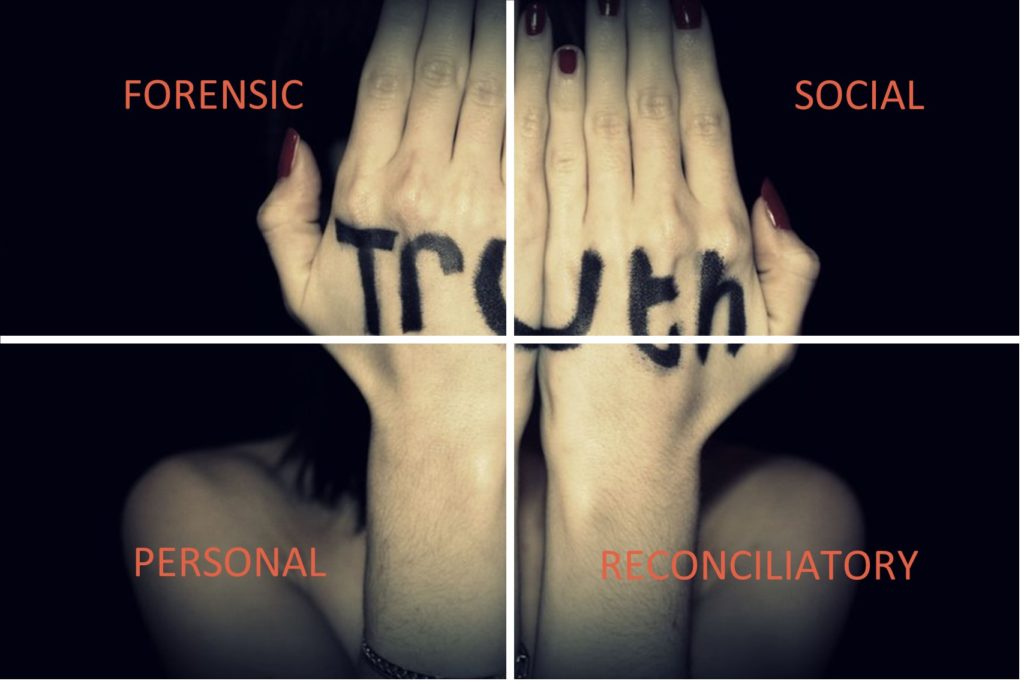
A potentially useful framework for approaching potential exhibition of materials from the Attica collection may be the “Four Truths” advocated by the International Coalition of Sites of Conscience (www.sitesofconscience.org) and which emerged from Truth and Reconciliation processes in South Africa, Latin America, the former Yugoslavia, and elsewhere. This dialogic approach moves away from a “transmission of knowledge” familiar to historians in favor of asking questions and creating conversations between the audience and the content of an exhibition, as well as among members of the audience. Through this framework, museum visitors are permitted to engage with difficult topics like Attica from a variety of starting points. The Four Truths, as explained by SOC Director of Outreach Sarah Pharoan, are forensic truths; personal truths; social truths; and reconciliatory, or healing truths. As historians and museum professionals, we have almost exclusively operated within the realm of forensic truths. These are the stories and histories that can be identified (and confirmed) by the artifact or written records. This is where the “stuff” is on which museum exhibitions are usually based. As has been outlined previously, however, reliance solely on the forensic truth when working with the Attica collections is immediately problematic and closes off multiple potential narrative pathways within the exhibition. Thus we historians need to move outside our usual comfort zones and engage with the other truths available to us and our audience. By grounding our work in the forensic truths established through the collections and archival records, but maintaining and confronting the silences within those collections, and by avoiding single-sided historicity or closed interpretation, we afford the audience a means to process topics such as Attica absent an authoritative historical voice. By asking questions rather than stating facts, historians can engage our audiences to navigate these difficult topics through a variety of paths.
The framework established by Sites of Conscience provides “safe spaces to remember and preserve even the most traumatic memories, but they enable their visitors to make connections between the past and related contemporary human rights issues.”[xxxvii] The objects within the Attica collections and the narratives they can support will allow future research and exhibition to draw attention and create dialog regarding contemporary issues round race, mass incarceration, and criminal justice. Through the dialogic approach, however, the Attica collections afford an opportunity to encourage debate and conversation around topics that are largely avoided in many portions of society, and, just maybe, prompt action for change within the museum’s audience.
Conclusion
While Trouillot’s Silencing the Past was first published in 1995, it has not been widely promulgated within the public history field to any significant degree until relatively recently. Even though many of Trouillot’s arguments and assertions have been more widely disseminated within academic circles, these concepts often appear anathema to established methodologies for interpreting objects within a museum exhibition.
That the objects from the Attica Prison Uprising survive is, in itself somewhat remarkable. Because the events at Attica do not conform to a traditional heroic narrative, such materials are very often lost to history during the creation of Trouillot’s archival silences. In many instances at sites of violence and tragedy, a movement towards obliteration of the event often occurs in which there is frequently a push for “actively effacing all evidence of a tragedy to cover it up or remove it from view.”[xxxviii] As Foote notes, “After riots or massacres, the minority group will assert that the tragedy illustrates principles worth remembering, only to find itself opposed by a more powerful or larger group wishing to ignore the event.”[xxxix] David Lowenthal, in acknowledging the important role played by artifacts in the dissemination of history, notes that “relics crucially bridge then and now.”[xl] Indeed, the objects within the Attica collections at the New York State Museum afford the potential for a visceral connection to the violent struggles that occurred at Attica State Correctional Facility in September 1971. Through this act of preservation, these objects of tragedy are imbued with a “vestige of the past” and are “mark[ed], protect[ed], and enhance[ed]” to make them accessible to generations to come.[xli]
The continued development of an interactive collections dashboard as part of the larger Attica exhibition development project is intended to foster greater ease of access to the Attica collections at the New York State Museum not only by museum staff, but by collaborative stakeholders in the exhibit process as well as scholars and other public historians working towards commemoration of the 50th Anniversary of the Attica Prison Uprising in September of 2021. Utilizing opportunities afforded by digital history projects such as “Mapping the Attica Collections” offers great potential for not only increased awareness and access to historical collections within museums, but also the opportunity for museum professionals to better utilize their collections to maximize the stories that these powerful artifacts can tell.
The goal of any research or exhibition utilizing these collections at the New York State Museum cannot be satisfied with the simple transmission of knowledge. The power and potency of the artifacts must transcend the events of the past, and it is imperative that they “establish some relation to that knowledge” in order to create an empathetic connection between past and present.[xlii] If employed correctly, such powerful narratives can offer badly-needed space for dialogue about contemporary issues such as criminal justice and prison reform outside of traditional spheres for such conversations. The choices made with this collection regarding future research and exhibition has the potential, as Lowenthal states, to “vitally affect how the past is experienced.”[xliii] Efforts to utilize the Attica collections at the New York State Museum must move beyond the notion that “relics mean only what history and memory tell us they convey.” [xliv] By acknowledging the presence of archival silences within the collections, historians must shed light on these constructed voids within the historical narrative and allow these powerful artifacts to interpret histories and memories long ago suppressed. As discussed, this will require a significant level of discussion and reevaluation within the museum as to how to approach a collection in which standard protocols for cataloging and artifact processing not only fail to acknowledge the archival silences within the collection, but also threatens to help, however inadvertently, to perpetuate the dominant historical narrative.
The issues surrounding the Attica collection pose unique challenges, but also opportunities for the New York State Museum. As Michel-Rolph Trouillot notes, each “historical narrative is a particular bundle of silences, the result of a unique process.”[xlv] With the Attica collection, there is likely no single process or method that can be employed to easily deconstruct these silences. Doing so will required a sustained effort directed along several fronts. Through continued evaluation and adaptation of standard museum cataloging practices, museum staff can not only acknowledge the presence of archival silences, but also take proactive measures to begin countering these silences in the historical record. The exploration and utilization of interpretive frameworks such as the four truths and a dialogic approach to any future exhibitions will also provide the museum with a means to actively confront the silences in the historical narrative, and to give voice to those portions of the story that have been largely silenced for nearly half a century. The process will not be an easy one, but it is one that is vitally necessary and long overdue.
Notes
[i] Ayers, Edward. “The Civil War in the Twenty-First Century,” Backstory, episode #0277, May 3, 2019 (Charlottesville: Virginia Humanities, 2019), https://www.backstoryradio.org/shows/the-civil-war-in-the-21st-century, accessed May 9, 2019
[ii] Lowenthal, David. The Past is a Foreign Country Revisited (New York: Cambridge University Press, 2015), p. 292
[iii] Lowenthal, David, The Past is a Foreign Country, (Cambridge: Cambridge University Press, 1985), p. 187
[iv] Lowenthal (1985), p. 206-207
[v] Lowenthal (1985), p. 212-224
[vi] Trouillot, Michel-Rolph. Silencing the Past: Power and the Production of History, 2nd Revised Edition (New York: Beacon Press, 2015), p. xxiii
[vii] Trouillot, p. 26
[viii] Trouillot, p. 27
[ix] Trouillot, p. 13-15
[x] McKay, Robert. Attica: The Official Report of the New York State Special Commission on Attica (New York: Bantam Books, 1972), p. 114-119
[xi] McKay, p. 134
[xii] McKay, p. 28
[xiii] McKay, p. 34-36
[xiv] McKay, p. 134-138
[xv] McKay, p. 335
[xvi] Meyer, Bernard S. “Final Report of the Special Attica Investigation,” Vol. 1, October 1, 1975, p. 50
[xvii] Meyer, p. 51
[xviii] Trouillot, p. 26
[xix] Meyer, p. 54-55
[xx] Meyer, p. 119
[xxi] McKay, p. 455-458
[xxii] Thompson, Heather Ann. Blood in the Water: The Attica Prison Uprising of 1971 and its Legacy (New York: Vintage, 2016), p. 239
[xxiii] McKay, p. 346
[xxiv] Chieco, S.A., Major and Technical Sergeant Walter J. Hornberger. Report, “Explosive Disposal – Attica Prison,” November 12, 1971
[xxiv] Bell, Malcolm. The Attica Turkey Shoot: Carnage, Cover-Up, and the Pursuit of Justice (New York: Skyhorse Publishing, 2017), p.54
[xxv] Bell, p. 4
[xxvi] Bell, p. 66
[xxvii] Meyer, p. 2
[xxviii] Bell, p. 45
[xxix] Foote, Kenneth E. Shadowed Ground: America’s Landscapes of Violence and Tragedy, Revised and Updated. (Austin: University of Texas Press, 2003), p. 18
[xxx] McKay, p. 195
[xxxi] McKay, p. 73
[xxxii] Trouillot, p. 30
[xxxiii] Lowenthal, p. 102.
[xxxiv] Trouillot, p. 48
[xxxv] Trouillot, p. 147
[xxxvi] Trouillot, p. 146
[xxxvii] International Coalition of Sites of Conscience (https://www.sitesofconscience.org/en/who-we-are/about-us/), accessed April 27, 2019
[xxxviii] Foote, p. 24; see also Lowenthal, p. 138-139
[xxxix] Foote, p. 11
[xl] Lowenthal, p. 20
[xli] Lowenthal, p. 20, 210
[xlii] Trouillot, p. 149
[xliii] Lowenthal, p. 20
[xliv] Lowenthal, p. 398
[xlv] Trouillot, p. 27
Bibliography
Adair, Bill, Benjamin Filene, and Laura Koloski, eds. Letting Go? Sharing Historical Authority in a User-Generated World (Walnut Creek, CA: Left Coast Press, 2011)
Attica: The Official Report of the New York State Special Commission on Attica (New York: Bantam Books, 1972)
Bell, Malcolm. The Attica Turkey Shoot: Carnage, Cover-up, and the Pursuit of Justice (New York: Skyhorse Publishing, 2017)
Foote, Kenneth E. Shadowed Grounds: America’s Landscape of Violence and Tragedy, Revised and Updated, (Austin: University of Texas Press, 2003)
Lowenthal, David, The Past is a Foreign Country, (Cambridge: Cambridge University Press, 1985)
Lowenthal, David. The Past is a Foreign Country – Revisited, (New York: Cambridge University Press, 2015)
Meyer, Bernard. “Final Report of the Special Attica Investigation,” October 27, 1995, https://ag.ny.gov/pdfs/MeyerReportVol1.pdf (Vol. 1); https://ag.ny.gov/pdfs/MeyerReportVol2And3.pdf (Vol 2 and 3)
New York State Archives, “The Attica Uprising and Aftermath: Selected Documents from the Office of the Attorney General,” www.archives.nysed.gov/research/oag/attica-documents
New York State Police. Fifty-Fourth Annual Report of the New York State Police for the Year 1971, p. 36-40
Thompson, Heather Ann. Blood in the Water: The Attica Prison Uprising of 1971 and its Legacy (New York: Pantheon, 2016)
Trouillot, Michel-Rolph. Silencing the Past: Power and the Production of History (Boston: Beacon Press, 1995, 2015)
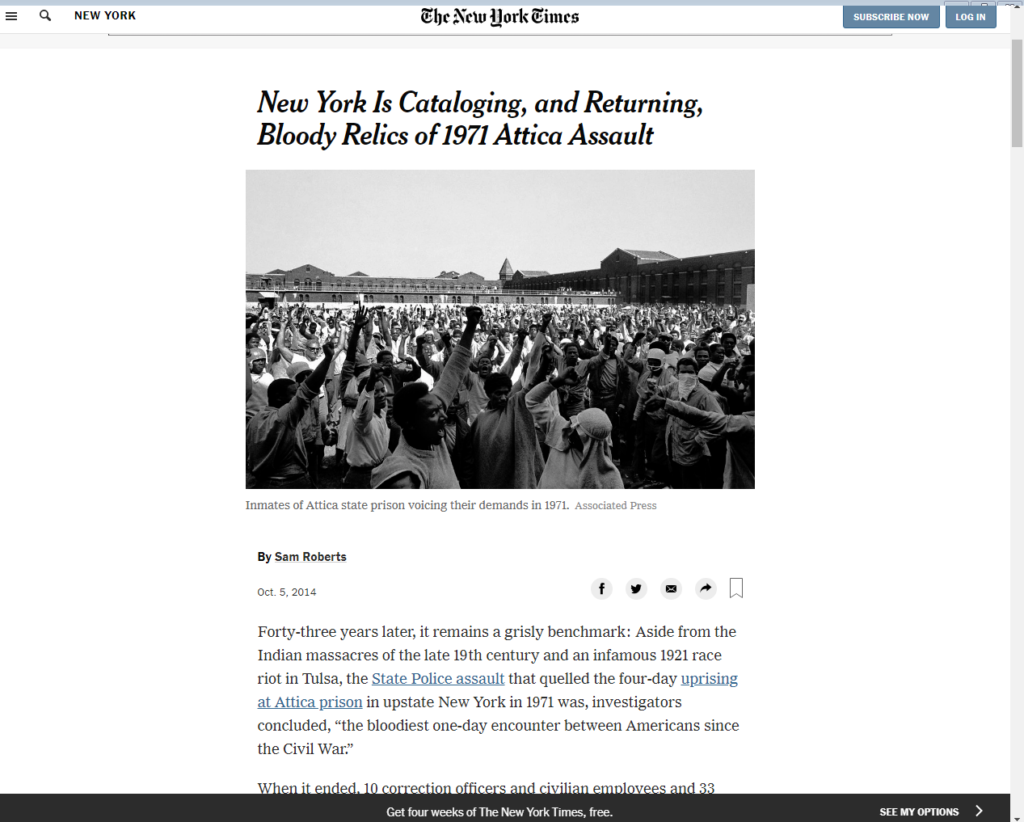
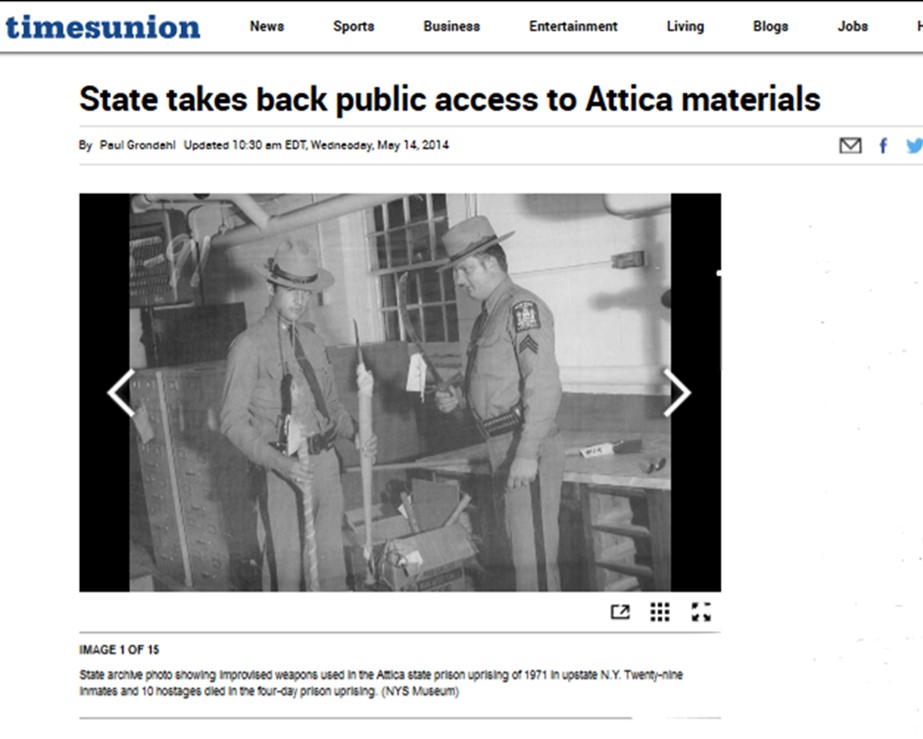
One Comment
Maeve Kane
The intro paragraph makes it unclear who your audience is–from the body of the piece, it seems to be both museum professionals and educated lay readers. Can you flip the intro paragraph to foreground what’s important about this collection? Foreground its size and the issues with its creation; as it stands now the structure suggests that the most important thing about this collection is the process of finding it in a quonset hut.
The lead images–especially the one of the objects in the yard–are very striking, and more context tying them in would be helpful. The Trouillot section is not particularly well tied to the rest of the piece–can you walk us through how this material was collected, or supposed to be collected, as an example of what Trouillot discusses? Where do Trouillot’s silences apply with this particular collection, and does it apply to other museum collections more broadly? Depending on your intended audience, does that affect how a museum professional should approach other collections, or how a museum visitor should approach this particular collection? More context on the screencaps of the headlines would also be helpful–what’s the dates, what do you think they say about public perception of the event or the collection?
Get rid of the axis labels for the map–they’re meaningless for you and they’re distracting. Why include the static images on the dashboard? I think you’d better use your space by rotating the bar graph horizontally, placing it along the bottom, and getting rid of your static images. Then the map could have a little more breathing room. The bar graph is also difficult to parse because there’s no color key and basically all the locations except for No Tag are very small. I’d do one color for your bar graph, sort it from largest to smallest, and let the map do the talking for locations. What does the color on the maps signify? They don’t appear to correlate to the colors in your bar graph. Your filtered bar graph after hovering over map locations is also redundant with the bar graph in the tooltip, but it’s confusing because the aspect ratio makes them appear to convey different information at first. Can you put something else in the tooltip if you’re going to filter the bargraph in the dashboard?
I think I see the point of including the screencaps of the dashboards, but made that small, they’re very claustrophobic. If you want to include those, I suggest either A. making a separate dashboard to screencap that will be less crowded looking at small size, or B. just doing a cap of an individual sheet.
Your first Bell quote is intriguing–is there an implication there that they didn’t want the defense to get a hold of the crank?
Structurally, your pieces are fighting each other. The section immediately following the timeline is incredibly compelling, as is the Malcolm Bell section. The section you open with now, from the intro through to the “Drawing conclusions” section, is very technical and presumes a lot of background knowledge that you actually establish in later sections. I suggest moving the timeline and Malcolm Bell sections to the top as your opener, then what’s now the intro through “drawing conclusions” sections, and then finish with the “Confronting Silences” section.
The larger version of the bar graph is intriguing re: your point about how the investigators vs the museum classified objects. Clothing and personal objects were more likely to be collected from the medical examiner’s office or the county hospital, while the largest number of tools and weapons to be collected from specific areas were collected from Times Square and the hostage area–what does that say about the investigators’ collection practices?
Do you think it’s possible to parse what evidence might have been destroyed? Are there object types that are more likely to have no tag, or to not be in the collection that one might expect? I find it rather notable that none of the kitchen equipment was collected from the kitchen area–what were the investigators thinking was typical? Were there areas of the prison that were not taken over, and this affected collection patterns? (eg, areas that were never taken over weren’t investigated for evidence that might be held against guards?) The oxygen cylinder caption is a great illustration of your points and should be pulled into the main text.
Regarding your last section before the conclusion, are there alternative categorizations (like religiously affiliated objects?) that might contextualize the story differently? Do the limitations of digital methods, like having to assign things to one and only one category, illustrate some of your points about the way this narrative has been shaped? What would a data schema designed by someone imprisoned at Attica look like?
Some typos: evidence from the in a Quonset hut; (timeline slide for 9AM Sept 13) Eight blindfolder hostages are brough up